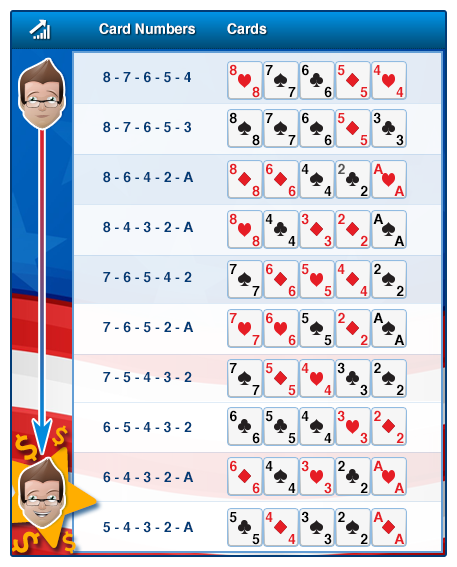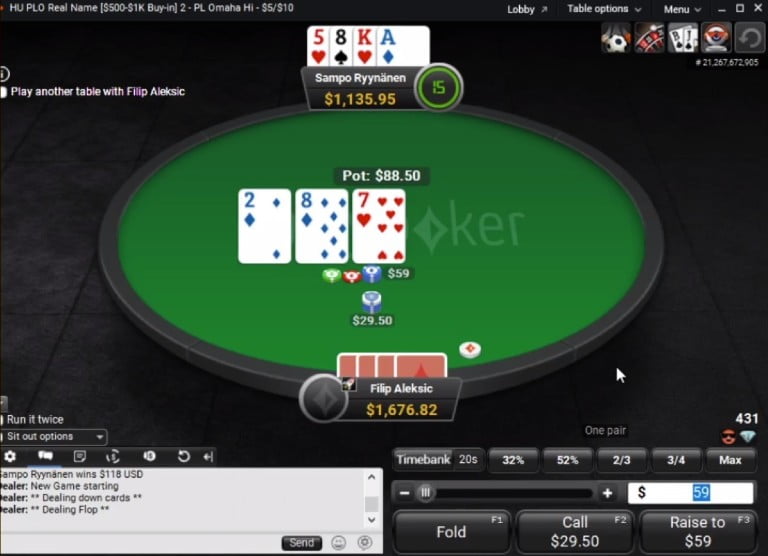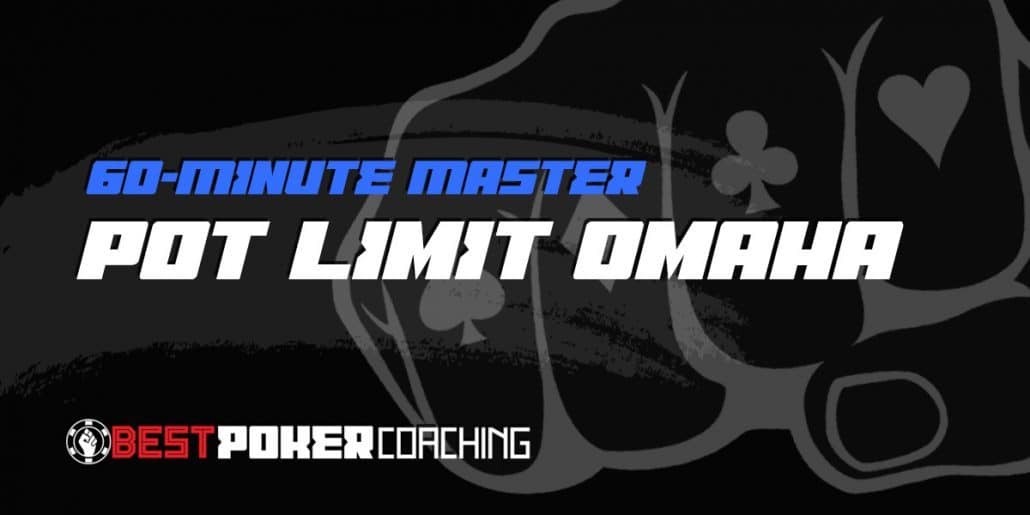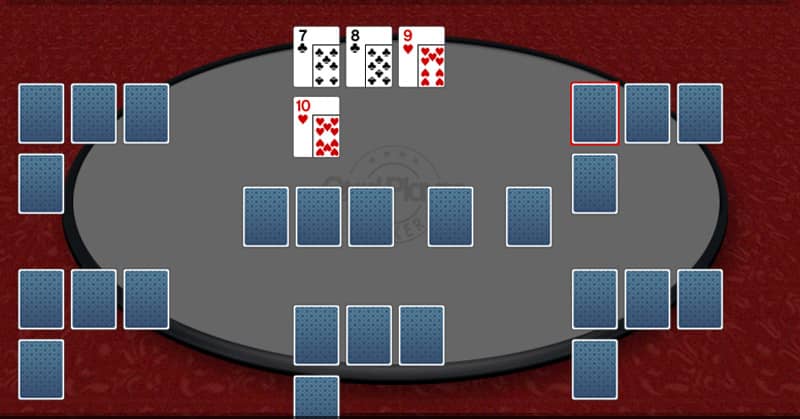Best Hands In Plo

With that said it is generally agreed that AAKK double suited is the best hand you could hope to get dealt in PLO: That said, the key to a great starting hand in Pot Limit Omaha is floppability, a clumsy term, I know, but forgive me for a moment. It’s important to realise the.reason. why AAKK double suited is the best starting hand. Any hands featuring any pair of Aces with two broadway cards (Ten to King), are the best hands in PLO. You should raise and reraise with these hands and, if it is possible, go all-in before the flop. These types of hands don’t need too much help to win and have good chances against a hand. A A K K is the best Omaha starting hand, but right next to it is, surprisingly, A A J T as it has much more straight potential than the third-best hand, A A Q Q. Almost all the top 30 hands from our chart have at least one strong pair in them: either A A, K K, Q Q or J J. Only two hands don't have a pair – J T 9 8 and K Q J T. Making strong hands is relatively easy in PLO, so it is preferable to play hands that can. The difference between Pot Limit Omaha (PLO) and No Limit Hold'Em (NLH) is still massively underestimated. When starting out in PLO, it's imperative that you adjust your starting hands from NLHE. In Hold 'Em, a hand like q q is considered extremely strong, however, in PLO, a hand like q q 8 3 is a very weak hand and should almost never be played.
“What is the best starting hand in Pot Limit Omaha?” is something I get asked a lot and unlike in No Limit Hold Em the answer isn’t actually as immediately obvious, this is because in Omaha hands almost always see a flop and so their absolute pre-flop equity is not nearly as important; additionally hand values run a lot closer together in general, meaning however strong a starting hand you have it’s a lot easier for your opponent to out flop your holding. With that said it is generally agreed that AAKK double suited is the best hand you could hope to get dealt in PLO:
Best Hands To Play In Plo
That said, the key to a great starting hand in Pot Limit Omaha is floppability, a clumsy term, I know, but forgive me for a moment. It’s important to realise the *reason* why AAKK double suited is the best starting hand. It’s not because it has AA in it, that’s really only a big advantage if you can get most of your money in pre-flop, no the reason it’s the best hand is because it can flop either the nuts in lots of different ways or it can flop draws to the nuts.
Here are a few flops that As Ks Ad Kd could hit where you’d usually be super happy to get your money in even when you’re playing with a deep stack and the pot is small on the flop:
You’ve flopped top set, if you can get it in here you’re almost always going to be a favourite.
you have two overpairs the nut flush draw and a gutshot, getting all in on this kind of a board is always going to be good for you. Even in a worst case scenario and you’re against QQxx you’re going to be roughly a coinflip. In all other situations you’ll range from a clear favourite to a huge favourite. In spots like this the value of having the nut flush draw is extremely important. You’ll often get it in against a hand like 89TJ with the same flush draw, in this spot you are a massive (for PLO) 75% favourite to win the pot, however if you were to get all in against the very same hand holding AA52 rainbow (all different suits) you’d actually be a 29% underdog! This should clearly demonstrate the value of “Good aces” versus “Bad aces”, with a hand like AAKKds you will flop opportunities to get lots of money in with great equity far more often!
Again you’ve flopped an overpair and the nut flush draw. In situations like this you will normally be very happy getting money in, especially against an aggressive opponent. Just imagine he is holding Q875 for top two pair, he excitedly gets all his money in, putting you on an overpair, well in this situation you’re actually a 54% favourite, against other hands he might be shoving, like top pair + a lower flush draw you’ll have your opponent absolutely crushed!
What I’m trying to illustrate here is that by reraising pre-flop and playing AAKKds fast and aggressively you will flop a lot of good situations to get a lot of money in, on the other hand consider the following:
Best Hands In Plo 4
Although this is still a premium hand in the right circumstances it’s actually extremely difficult to make a lot of money with if you’re playing a cash game with deep stacks. Why? Because unless you flop top set it’s going to be almost impossible to play. Take this hand up against the 3 situations I posted above, only the the 1st situation (flopping the top set) will this hand play well, in the other two you will likely get money in a huge underdog. Secondly in the first situation you are twice as likely to flop top set because you have KK as your backup, with 8d 2h as your backup cards you’ll be rooting for a miracle to improve your hand.

If you can get 40% of your total stack in before the flop with any AAxx hand then you should do so and stack off on most flops, if however you are playing with deep stacks, either in a tournament or a cash game, you should understand the value of coordinated hands that will make you draws to the nuts.
So with that theory out of the way I hope you have a better idea of what kinds of hands you should consider the crème da la crème of pot limit omaha and why. Here are the complete top 10 omaha starting hands, as you look at them consider the many flops where they can flop big draws to the nuts or 2nd nuts and how coordinated the hands are. Remember Tc Jc Qd Kd is much, much, much stronger than Tc Jc Qd 4h:
Best Hands In Omaha Plo

| Ace Ace King King Double suited |
| Ace Ace Jack Ten Double Suited |
| Ace Ace Queen Queen Double Suited |
| Ace Ace Jack Jack Double Suited |
| Ace Ace Ten Ten Double Suited |
| Ace Ace Nine Nine Double Suited |
| Jack Ten Nine Eight Double Suited |
| King King Queen Queen Double Suited |
| King Queen Jack Ten Double Suited |
| King King Jack Jack Double Suited |
From this I’m sure you can begin to formulate in your mind what the next 20 or 30 strongest hands might be. Remember to get AAKKds in PLO is much rarer that getting dealt AA in No Limit Hold Em. Because of this you’ll usually be seeing a flop with at least the top 50 or so hands you could be dealt if you’re playing a ring game and a much wider range again in a heads up match.
I hope this has been of help and I’ll see you next time!
In this lesson we’re going to take a look at three groups of Omaha/8 starting hands and assess what represent real powerhouse starting hands. We’ll also examine some good Omaha/8 starting hands along with hands that are playable but where some degree of caution should be exercised. Unfortunately, one cannot expect to be dealt a powerhouse hand on every deal.
Powerhouse Omaha/8 Starting Hands
This is my favourite starting hand in Omaha/8 since it gives top pair, two nut flush draws and a great draw to the nut low including counterfeit protection. Counterfeit protection means that if an ace, deuce or trey hits the board you still have the two best low cards to put with it. As an example, if the final board was K-2-5-Q-4, your deuce would have been counterfeited but you would still have the nut low (using one of your aces and the trey) as well as a straight. If three of the cards were either clubs or spades, you would have the nut flush for high with a wheel (five-high straight) for low. This would be a very good holding hoping to scoop the entire pot. If another player held the nut low as well but your high hand was the winner, you would win three quarters of the pot made up of the high half and half of the low half.
Plo Starting Hand Chart
While this Omaha/8 hand offers no low possibility, since you must use two cards from your hand, it does offer two nut flushes, straight possibilities with two different high pairs which could make sets and then, if the board pairs, very good full houses. This is the type of hand where you hope that no one qualifies for low and you can scoop the pot with just a winning high hand. However, there’s a danger in flopping a set with your pair of aces, or with any pair that’s eight or lower. The danger is that you’ve already put one low card on the board, and you may be vying for only half the pot instead of all of it.
This is an excellent Omaha/8 starting hand because you have four low cards offering double counterfeit protection coupled with straight draws and the nut flush draw. Having the three and four suited does not add value as a four high flush with three of that suit on the board is really a liability and not an asset.
Good Omaha/8 Starting Hands

This hand provides no possibility of a low hand so you would definitely like to see all high cards on the flop including a ten. There are also two flush draws, one to the nut and the other to the second nut. This is the kind of hand that, if no or only one low card flops you need to raise and re-raise to make it very expensive for low hands to chase in order to qualify. The object here is to scoop a one way pot for high. In fact, if you’re in late position and a number of players have already entered the pot, you should raise. Most of your opponents will play low hands, and a large number of opponents points to a deck that is presumptively rich in high cards, which favor your hand. So go ahead and get more money in the pot. If the flop contains big cards, you are likely to scoop. If it contains all low cards, you can easily release your hand.
This Omaha/8 hand offers the opportunity of a nut flush, nut low and straight draws. With a pair you can also flop a set or even quads. Counterfeit protection is part of its upside as well. This is a good hand that is not quite a powerhouse.
While you usually want an ace in your hand this Omaha/8 hand represents very good counterfeit protection. Obviously, you would like to see an ace and two small cards hit the flop which would give you a nut low. The straight draws enhance the value of this starting hand. You’ll notice this isn’t double suited since getting a four or five high flush is really of no value. This hand’s value is in straights and lows with counterfeit protection.
Playable with Some Caution, Starting Hands
This is an example of a playable Omaha/8 hand where caution should be exercised. While there are two flush draws and a myriad of straight draws they are all somewhat problematic. In an action game like Omaha/8, where there is frequent raising, it can be very expensive to wind up with a second best hand for high or low. With a hand like this, if you make a low hand, it is unlikely to be the best low, and even a straight may not be the nut straight. Moreover, any flush you make may not be the best flush either.
This hand is a far cry from the two pair hand of A-A-K-K which was highlighted in the powerhouse section. While it looks good, including the straight possibilities and jack-high flush draw, caution is recommended anytime you’re not drawing to the nuts. It doesn’t mean you shouldn’t play them, but it does mean you should be a bit cautious when you do.

Here is another hand that on the surface looks pretty good with draws to both a king- and queen-high flush, straight draws, and two good low cards. While the winning hand can certainly be made with this start, the hand can also lead to trouble with a capital “T”. This hand exemplifies just how important an ace in your starting hand really is. You cannot make a nut flush or a nut straight or a nut low unless an ace comes on the board.
I’ve offered up three examples in each of the three categories to highlight what I believe represent the powerhouses, just good, as cautiously playable starting hands. Obviously this is not meant to be a complete listing but to give you a sense of the upsides and downsides of Omaha/8 starting hands. As with all forms of poker, your starting hand values need to be viewed in concert with your position, the texture of the game, your opponents’ playing styles, as well as your own style and the degree of risk you enjoy.
Related Lessons
By Tom 'TIME' Leonard
Tom has been writing about poker since 1994 and has played across the USA for over 40 years, playing every game in almost every card room in Atlantic City, California and Las Vegas.